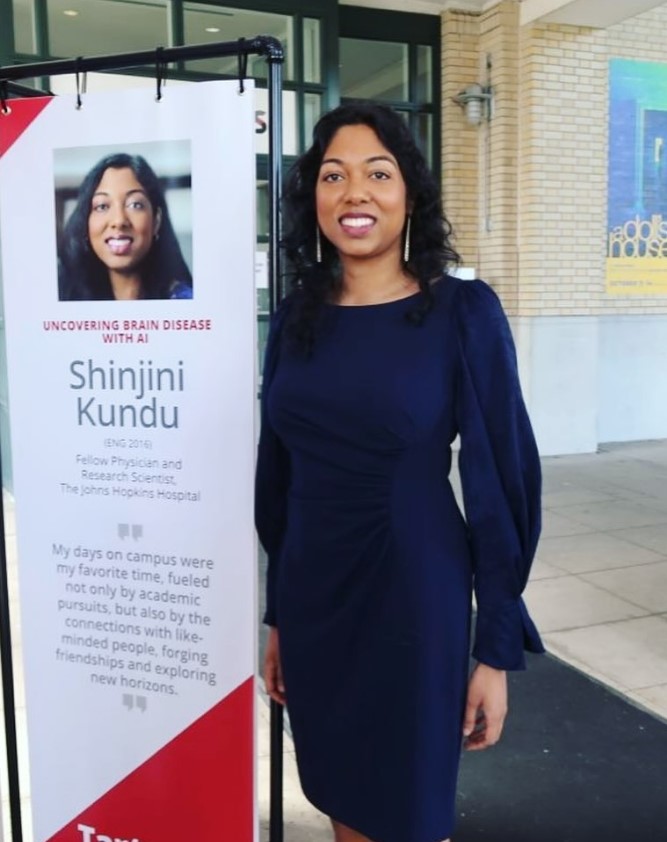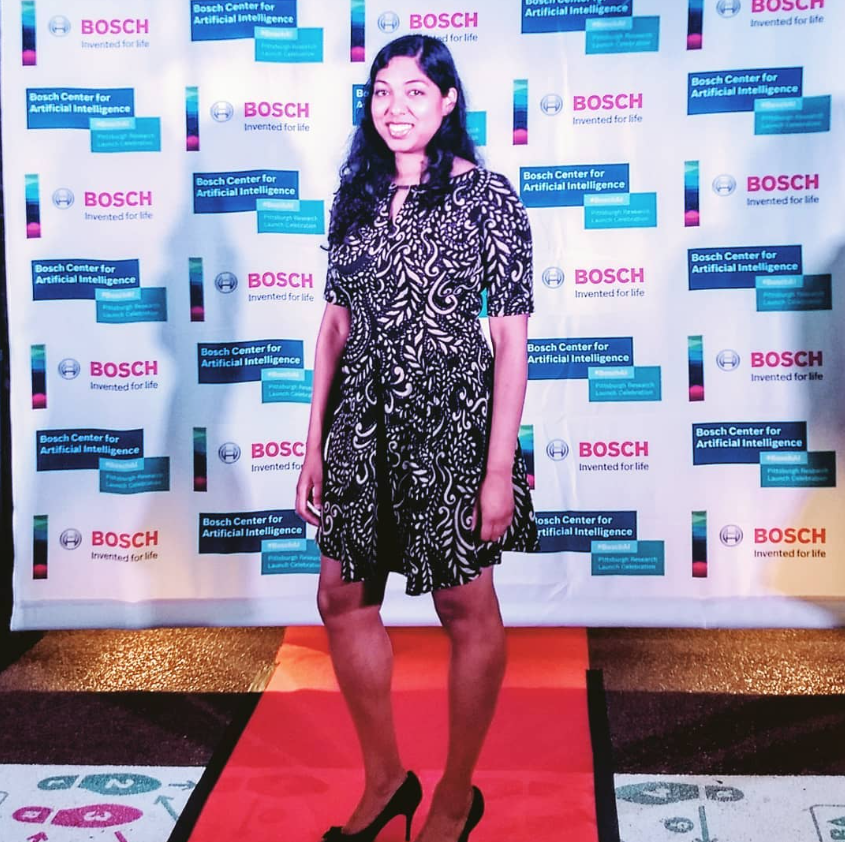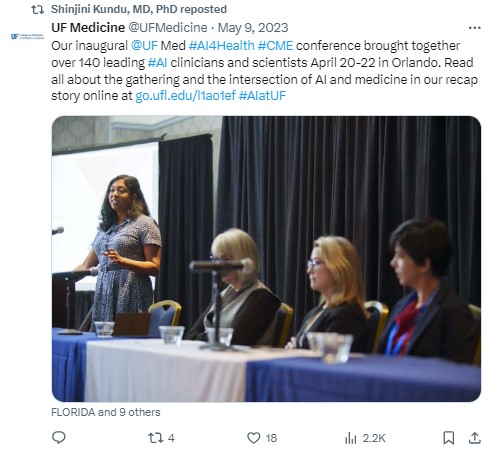(May 3, 2024) “After many years of research, I developed a new AI technique called Transport-based Morphometry which is like a smart Sherlock Holmes sniffing out subtle clues,” Shinjini remarked in a TEDxGateway talk a few years back. A physician and computer scientist at The Johns Hopkins Hospital, Shinjini is known for using her unique expertise at the intersection of engineering and medicine to detect diseases currently imperceptible to humans.
For her enormous efforts to transform medical diagnosis with the help of AI, the physician and scientist has earned international acclaim. She was named in the Forbes 30 under 30 list in 2018, and was in the MIT Technology Review’s 35 innovators under 35 list for creating an artificial-intelligence system that can analyse medical images to find patterns undetectable by the naked eye. The World Economic Forum Young Global Leader has also earned the Carnegie Science Award for her research work.

Shinjini Kundu during Carnegie Mellon University’s Tartans on the Rise awards ceremony
Renowned for her expertise in diagnosing diseases from medical images at an early stage, even when imaging options like MRI scans fail to reveal human-identifiable abnormalities, Shinjini has utilised artificial intelligence to make previously unnoticed patterns discernible. Her contributions have significantly impacted the field of diagnosis.
Accolades along the way
“Eight years after graduating with my PhD, I was thankful to be back in Pittsburgh over the weekend to attend the Carnegie Mellon University 2024 Tartans on the Rise awards ceremony. Grateful to be named one of this year’s alumni awardees,” Shinjini Kundu shared joyfully recently.
In the past she has given talks on the impact of AI on healthcare at prestigious platforms like TEDx, World Business Dialogue and the United Nations. She has authored or co-authored close to 20 peer-reviewed articles for journals like Nature Medicine and Proceedings of the National Academy of Sciences and has also presented her research work at the International Conference on Acoustics, Speech, and Signal Processing.
In 2018, Kundu spoke at the United Nations AI for Good Global Summit in Geneva, Switzerland. Her advocacy for transparent AI in medicine played a significant role in its adoption as a priority area under Sustainable Development Goal 3.

Shinjini Kundu received Carnegie Mellon University 2024 Tartans on the Rise Award
The physician and scientist has also contributed to the emerging digital health policies of the American Medical Association, and the digital privacy policies at the Observer Research Foundation. She was recognised as Pittsburgh Magazine’s 40 Under 40 in 2016.
Using AI to address a pressing need
One of Shinjini’s research projects successfully detected knee osteoarthritis three years before symptoms manifested. Her research centres on her innovative creations – Transport-based Morphometry (TBM), which utilizes machine learning techniques to detect underlying diseases that may not be easily identifiable through traditional imaging methods such as MRIs.
“My thought is that there’s more information in the images than meets the human eye. We can find this information and make sense of it using artificial intelligence in a lot of problems. There are hidden changes in the images that are invisible to the naked eye that a computer can find. It’s important to find these because sometimes they can indicate the imminence of disease, sometimes it can help you predict disease years before we ever knew that we could,” she said in an interview after winning the NRI Award – Times Now’s annually televised Indian awards show recognising achievements by those of Indian descent.
AI – the Sherlock Holmes in medical diagnosis
It has been her curiosity that has fuelled Shinjini’s journey to uncover many invisible clues in the field of medical diagnosis. Her work centres on analysing medical scan images (Xray, MRI, CT scan reports), with a focus not on what is visible, but on what remains hidden within those images.
“It’s not long ago that surgery used to be the only way to see inside. Images are one of our fastest growing sources of medical data today and there are even newer imaging technologies coming up. Images are interpreted by a medical doctor like me trained in radiology,” she remarked in one of her talks, “But I am not here to talk about the visible side of imaging, I am not here to talk about the side of imaging that everybody sees. I am here to talk about the dark side of imaging, the side that we haven’t been able to see and the side that we didn’t even know existed until recently,” she revealed.
Highlighting her quest to uncover the invisible, she illustrated a scenario in a TEDxGateway talk, telling audiences to imagine playing cricket, where a ball strikes a person on the head, leaving him feeling dizzy. Upon returning to the game after resting, his team members notice a decrease in reaction time. A visit to the doctor confirms a concussion, which slowed the player’s responses. Despite examining 10 other concussion patients that day, the doctor cannot discern any visual patterns in the variations of reaction times of those patients.
Such hypotheses led her to ponder if hidden complexities exist beyond a medical professional’s perception, potentially unlocking insights into otherwise cryptic diseases. This curiosity led her to delve into the ‘dark side’ of imaging and devise unique methods like 3D Transport-based Morphometry. “It can crack cases like a smart Sherlock Holmes, sniffing out subtle clues and solving the mystery even before humans can,” she remarked
A solid background
When Shinjini was in high school, she used to find great interest in assisting her father, a computer engineer, in dismantling computers. This in fact, influenced her academic path – she went on to earn her bachelor’s and master’s degrees in electrical engineering from Stanford University. During her time at Stanford, she also served as editor-in-chief of the university’s undergraduate research journal.
It was during this time that a class on medical imaging sparked Shinjini’s interest in the medical field, motivating her to polish her expertise to expedite patient diagnoses. As a result, she enrolled in the Medical Scientist Training Program jointly conducted by Carnegie Mellon University and the University of Pittsburgh, and then went on to do PhD.

Shinjini Kundu at launch party for Bosch Center for AI at her alma mater CMU in 2018
Talking about her doctorate programme the Global Indian shared in an interview, “My PhD was the hardest thing I have ever done. There is so much uncertainty and you are trying to explore uncharted territory and to create a research contribution that nobody has ever explored before. So, you don’t know if it’s going to work. You could be working on it for three months and it could lead to nowhere and that can be demoralising and at the same time you could be working on something and have a breakthrough and that could be really energising. So, just keep going, no matter what the ups and downs.”
Talking about her motivation during those years she remarked, “My thought was that if you can diagnose it years before that bone damage and that pain develops then maybe there’s a chance that you can sort of halt the process or maybe even slow down the trajectory and that was the motivation for it.”
She looks at technology as an enabler for the medical diagnostics and treatments in current times. “I want to be an enabler of the technology and I also want it to be on the other side and see the impact that I had on patients. So that’s why I decided to do an MD and a PhD,” she shared.
While growing up Shinjini was not only interested in STEM. She also trained as an Indian classical dancer and even performed at reputed places like the Madison Square Garden, a multi-purpose indoor arena in New York City.




